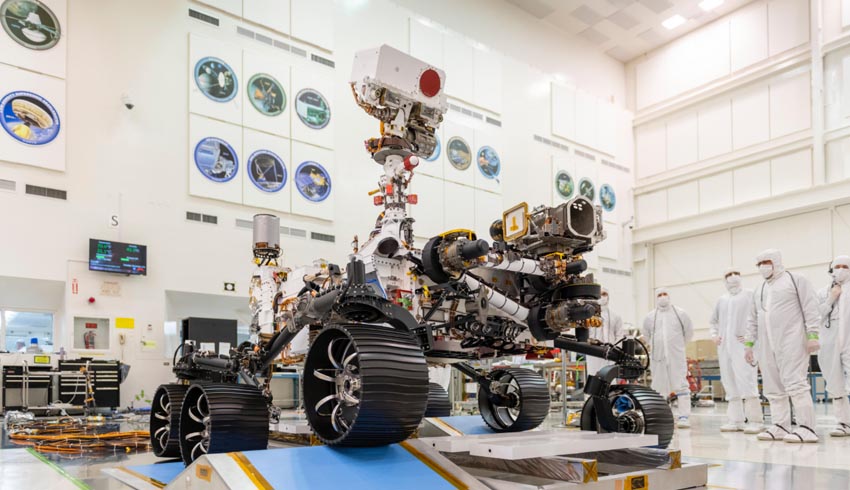
Jezero crater, the 49-kilometre-wide destination of Perseverance, contains sediments of an ancient river delta, a location where evidence of past life could be preserved – if life ever did arise on Mars.
Professor Sanjeev Gupta, from Imperial College London, will help NASA oversee mission operations from a science and engineering point of view and Professor Mark Sephton, also from Imperial College London, will be helping to identify samples from Mars that could contain evidence of past life.
Meanwhile, Professor Caroline Smith, from the Natural History Museum, will be studying the mineralogy and geochemistry of the different rocks found in Jezero crater. Dr Keyron Hickman-Lewis, who is preparing to join the Natural History Museum, will be studying the environments reflected by sedimentary rocks exposed in Jezero crater and the potential for signatures of ancient microbial life preserved within.
UK Science Minister Amanda Solloway said, “UK scientists and researchers continue to play an indispensable role in the most impressive international space missions, helping to further our understanding of our extraordinary solar system.”
NASA’s Perseverance rover and the recently launched UAE Hope mission will blaze a trail ahead of the launch of the UK-built Rosalind Franklin rover, due to blast into space in 2022.
Perseverance has several science goals for its mission, and is carrying instruments geared to search for the carbon building blocks of life and other microbes and to reconstruct the geological history of the Red Planet.
These instruments will analyse scientifically interesting samples from the surface. Selected samples will be collected by drilling down to seven centimetres and then sealed in special sample tubes and stored on the rover.
When the rover reaches a suitable location, the tubes will dropped on the surface of Mars to be collected by a future retrieval mission, which is currently being developed.
The Sample Fetch Rover, being developed by Airbus in Stevenage, will collect the samples and take them to the NASA Mars Ascent vehicle. Professor Smith is involved in working with NASA and ESA scientists planning for how the samples will be curated upon their return.
The rover also carries the Ingenuity Mars Helicopter, which will fly short distances from the rover and marks the first attempt at powered, controlled flight on another planet. A successful test of the helicopter could lead to more flying probes on other planets.
Sue Horne, head of space exploration at the UK Space Agency, said, “It is amazing that we are undertaking the first step of a sequence of missions to collect samples from Mars and return them to Earth. This has been on scientists’ wish list for 40 years and we now have the technology to achieve it and have started the missions needed.”
Perseverance will also be trialling technologies to help astronauts make future expeditions to Mars.
These include testing a method for producing oxygen from the Martian atmosphere, identifying other resources, such as subsurface water, improving landing techniques, and characterising weather and other potential environmental conditions that could affect future astronauts living and working on Mars.
Professor Gupta is also one of the 10 long-term planners for the mission. He will be working closely with the science team in developing the strategic science vision of the mission and making sure that it fulfils the science objectives and with the engineers in day-to-day rover operations as they search for samples of rocks for future return to Earth.
He said, “This is crucial to understand what the Martian climate was like early in Mars’ history and whether it was habitable for life. This information will be used to help us define the best spots to collect rock samples for future return to Earth.”
Professor Sephton is an astrobiologist who specialises in recognising the organic records of past life in rocks and will help the team select samples for eventual return to Earth.
He added, “I hope that the samples we select and return will help current and future generations of scientists answer the question of whether there was ever life on the Red Planet. With one carefully chosen sample from Mars, we could discover that the history of life on the Earth is not unique in the universe.”
In two years’ time, the Rosalind Franklin rover will go to Mars as part of the European Space Agency’s ExoMars mission to examine the geological environment on Mars and search for signs of life, past or present.
The Rosalind Franklin rover, which was built by Airbus in Stevenage, will be able to drill two metres below the surface, gathering samples from regions not affected by radiation.
This is a busy time for missions to Mars as we are in a window that opens every 26 months when the two planets align for the shortest journey. The United Arab Emirates’ Hope probe launched on 20 July and China also launched a rover on 23 July.
Receive the latest developments and updates on Australia’s space industry direct to your inbox. Subscribe today to Space Connect here.









